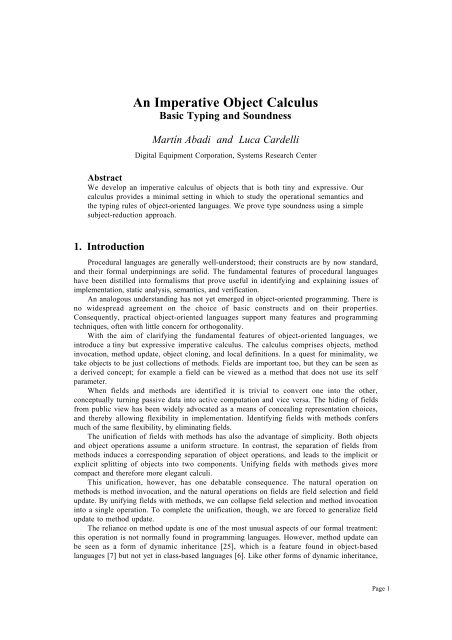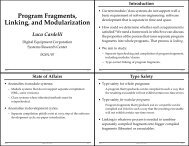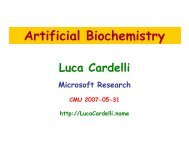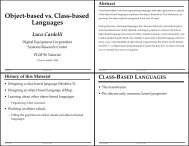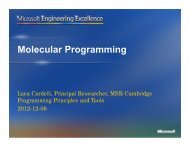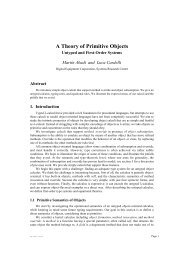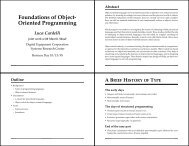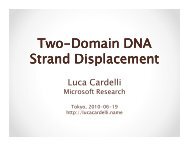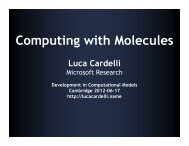An imperative object calculus: Basic typing and ... - Luca Cardelli
An imperative object calculus: Basic typing and ... - Luca Cardelli
An imperative object calculus: Basic typing and ... - Luca Cardelli
You also want an ePaper? Increase the reach of your titles
YUMPU automatically turns print PDFs into web optimized ePapers that Google loves.
<strong>An</strong> Imperative Object Calculus<br />
<strong>Basic</strong> Typing <strong>and</strong> Soundness<br />
Martín Abadi <strong>and</strong> <strong>Luca</strong> <strong>Cardelli</strong><br />
Digital Equipment Corporation, Systems Research Center<br />
Abstract<br />
We develop an <strong>imperative</strong> <strong>calculus</strong> of <strong>object</strong>s that is both tiny <strong>and</strong> expressive. Our<br />
<strong>calculus</strong> provides a minimal setting in which to study the operational semantics <strong>and</strong><br />
the <strong>typing</strong> rules of <strong>object</strong>-oriented languages. We prove type soundness using a simple<br />
subject-reduction approach.<br />
1. Introduction<br />
Procedural languages are generally well-understood; their constructs are by now st<strong>and</strong>ard,<br />
<strong>and</strong> their formal underpinnings are solid. The fundamental features of procedural languages<br />
have been distilled into formalisms that prove useful in identifying <strong>and</strong> explaining issues of<br />
implementation, static analysis, semantics, <strong>and</strong> verification.<br />
<strong>An</strong> analogous underst<strong>and</strong>ing has not yet emerged in <strong>object</strong>-oriented programming. There is<br />
no widespread agreement on the choice of basic constructs <strong>and</strong> on their properties.<br />
Consequently, practical <strong>object</strong>-oriented languages support many features <strong>and</strong> programming<br />
techniques, often with little concern for orthogonality.<br />
With the aim of clarifying the fundamental features of <strong>object</strong>-oriented languages, we<br />
introduce a tiny but expressive <strong>imperative</strong> <strong>calculus</strong>. The <strong>calculus</strong> comprises <strong>object</strong>s, method<br />
invocation, method update, <strong>object</strong> cloning, <strong>and</strong> local definitions. In a quest for minimality, we<br />
take <strong>object</strong>s to be just collections of methods. Fields are important too, but they can be seen as<br />
a derived concept; for example a field can be viewed as a method that does not use its self<br />
parameter.<br />
When fields <strong>and</strong> methods are identified it is trivial to convert one into the other,<br />
conceptually turning passive data into active computation <strong>and</strong> vice versa. The hiding of fields<br />
from public view has been widely advocated as a means of concealing representation choices,<br />
<strong>and</strong> thereby allowing flexibility in implementation. Identifying fields with methods confers<br />
much of the same flexibility, by eliminating fields.<br />
The unification of fields with methods has also the advantage of simplicity. Both <strong>object</strong>s<br />
<strong>and</strong> <strong>object</strong> operations assume a uniform structure. In contrast, the separation of fields from<br />
methods induces a corresponding separation of <strong>object</strong> operations, <strong>and</strong> leads to the implicit or<br />
explicit splitting of <strong>object</strong>s into two components. Unifying fields with methods gives more<br />
compact <strong>and</strong> therefore more elegant calculi.<br />
This unification, however, has one debatable consequence. The natural operation on<br />
methods is method invocation, <strong>and</strong> the natural operations on fields are field selection <strong>and</strong> field<br />
update. By unifying fields with methods, we can collapse field selection <strong>and</strong> method invocation<br />
into a single operation. To complete the unification, though, we are forced to generalize field<br />
update to method update.<br />
The reliance on method update is one of the most unusual aspects of our formal treatment:<br />
this operation is not normally found in programming languages. However, method update can<br />
be seen as a form of dynamic inheritance [25], which is a feature found in <strong>object</strong>-based<br />
languages [7] but not yet in class-based languages [6]. Like other forms of dynamic inheritance,<br />
Page 1
method update supports the dynamic modification of <strong>object</strong> behavior allowing <strong>object</strong>s, in a<br />
sense, to change their class dynamically. Thus, method update gives us an edge in modeling<br />
<strong>object</strong>-based constructions, in addition to allowing us to model the more traditional class-based<br />
constructions where fields <strong>and</strong> methods are sharply separated.<br />
A further justification for method update can be found in the desire to tame dynamic inheritance.<br />
Dynamic inheritance has potentially unpredictable effects, due to the updating of shared<br />
state. These concerns have led to the search for better-behaved, restricted, dynamic inheritance<br />
mechanisms [23]. Method update is one of these better-behaved mechanisms, especially in the<br />
absence of delegation, as in our <strong>calculus</strong>. Method update is statically typable, <strong>and</strong> can be used<br />
to emulate the mode-switching applications of dynamic inheritance [13]. With method update<br />
we avoid some dangerous aspects of dynamic inheritance [14, 23], while maintaining its<br />
dynamic specialization aspects originally advocated by the Treaty of Orl<strong>and</strong>o [22].<br />
In this paper, we study an untyped <strong>calculus</strong> (section 2), <strong>and</strong> then we present a type structure<br />
for it (section 3). The only type constructor is one for <strong>object</strong> types: an <strong>object</strong> type is a list of<br />
method names <strong>and</strong> method result types. A sub<strong>typing</strong> relation between <strong>object</strong> types supports<br />
<strong>object</strong> subsumption, which allows an <strong>object</strong> to be used where an <strong>object</strong> with fewer methods is<br />
expected. We prove the consistency of our rules using a subject-reduction approach (section 4).<br />
Our technique is an extension of Harper’s [16], using closures <strong>and</strong> stacks instead of formal<br />
substitutions. This approach yields a manageable proof for a realistic implementation strategy.<br />
Elsewhere we have considered functional calculi [2-4]. The main novelty here is the<br />
treatment of <strong>imperative</strong> features, with corresponding proof techniques. In further work [5] we<br />
treat second-order type structures (with Self types) for an <strong>imperative</strong> <strong>calculus</strong>.<br />
A few other <strong>object</strong> formalisms have been defined <strong>and</strong> studied. Many of these rely on purely<br />
functional models, with an emphasis on types [1, 8, 10, 12, 17, 19-21, 27]. Others deal with<br />
<strong>imperative</strong> features in the context of concurrency; see for example [29]. The works most closely<br />
related to ours are that of Eifrig et al. on LOOP [15] <strong>and</strong> that of Bruce <strong>and</strong> van Gent on TOIL<br />
[9]. LOOP <strong>and</strong> TOIL are typed, <strong>imperative</strong>, <strong>object</strong>-oriented languages with procedures, <strong>object</strong>s,<br />
<strong>and</strong> classes. Both take procedures, <strong>object</strong>s, <strong>and</strong> classes as primitive, with fairly complex rules;<br />
they also distinguish methods from fields. LOOP is translated into a somewhat simpler <strong>calculus</strong>,<br />
which includes record, function, reference, recursive, <strong>and</strong> F-bounded types. Our <strong>calculus</strong> is<br />
centered entirely on <strong>object</strong>s: procedures <strong>and</strong> classes can be defined from them. The collections<br />
of programs that can be written <strong>and</strong> typed in these formalisms are different. In spite of this, we<br />
all share the goal of modeling <strong>imperative</strong> <strong>object</strong>-oriented languages by precise semantic<br />
structures <strong>and</strong> sound type systems.<br />
2. <strong>An</strong> Untyped Imperative Calculus<br />
We begin with the syntax of an untyped <strong>imperative</strong> <strong>calculus</strong>. The initial syntax is minimal,<br />
but in sections 2.2 <strong>and</strong> 2.3 we show how to express convenient constructs such as fields <strong>and</strong><br />
procedures. We omit how to encode basic data types, control structures, <strong>and</strong> classes, which can<br />
be treated much as in [4]. In section 2.5 we give an operational semantics.<br />
2.1 Syntax<br />
Syntax of the imp-ς <strong>calculus</strong><br />
a,b ::=<br />
term<br />
x<br />
variable<br />
[l i =ς(x i )b iÏ1..n i ] <strong>object</strong> (l i distinct)<br />
a.l<br />
method invocation<br />
a.lfiüς(x)b<br />
method update<br />
Page 2
clone(a)<br />
let x = a in b<br />
cloning<br />
let<br />
<strong>An</strong> <strong>object</strong> is a collection of components l i =ς(x i )b i , for distinct labels l i <strong>and</strong> associated<br />
methods ς(x i )b i ; the order of these components does not matter, even for our deterministic<br />
operational semantics. The letter ς (sigma) is used as a binder for the self parameter of a method;<br />
ς(x)b is a method with self parameter x, to be bound to the host <strong>object</strong>, <strong>and</strong> body b.<br />
A method invocation o.l results in the evaluation of the body of the method named l, with o<br />
bound to the self parameter.<br />
A method update o.lfiüς(y)b replaces the method named l with ς(y)b in o, <strong>and</strong> returns the<br />
modified <strong>object</strong>.<br />
A cloning operation clone(o) produces a new <strong>object</strong> with the same labels as o, with each<br />
component sharing the methods of the corresponding component of o.<br />
The let construct evaluates a term, binds it to a variable, <strong>and</strong> then evaluates a second term<br />
with that variable in scope. Sequential evaluation can be defined from let, by:<br />
a;b @ let x=a in b,<br />
for x Ì FV(b).<br />
2.2 Fields<br />
In our imp-ς <strong>calculus</strong>, every component of an <strong>object</strong> contains a method. However, we can<br />
encode fields with eagerly evaluated contents by using the let construct. We write [l i =b i iÏ1..n ,<br />
l j =ς(x j )b j jÏ1..m ] for an <strong>object</strong> where l i =b i are fields <strong>and</strong> l j =ς(x j )b j are methods. We also write a.l:=b<br />
for field update, <strong>and</strong> a.l, as before, for field selection. We abbreviate:<br />
Encoding of fields<br />
[l i =b i iÏ1..n , l j =ς(x j )b j jÏ1..m ] for y i Ì FV(b i iÏ1..n , b j jÏ1..m ), y i distinct, iÏ0..n<br />
@ let y 1 =b 1 in ... let y n =b n in [l i =ς(y 0 )y i iÏ1..n , l j =ς(x j )b j jÏ1..m ]<br />
a.l:=b @ let y 1 =a in let y 2 =b in y 1 .lfiüς(y 0 )y 2 for y i Ì FV(b), y i distinct, iÏ0..2<br />
The semantics of an <strong>object</strong> with fields may depend on the order of its components, because of<br />
side-effects in computing contents of fields. The encoding specifies an evaluation order.<br />
By an update, a method can be changed into a field <strong>and</strong> vice versa. Thus, we use somewhat<br />
interchangeably the names selection <strong>and</strong> invocation.<br />
2.3 Procedures<br />
The imp-ς <strong>calculus</strong> is so minimal that it does not include procedures, but these can be expressed<br />
too. We begin by considering informally a call-by-value λ-<strong>calculus</strong> with side-effects,<br />
imp-λ, that includes abstraction, application, <strong>and</strong> assignment to λ-bound variables. For example,<br />
assuming arithmetic primitives, (λ(x) x:=x+1; x)(3) is an imp-λ term yielding 4. We translate<br />
imp-λ into imp-ς.<br />
Translation of procedures<br />
äxã ρ @ ρ(x) if xÏdom(ρ), <strong>and</strong> x otherwise<br />
äλ(x)bã ρ @ [arg = ς(x)x.arg, val = ς(x)äbã ρ{x←x.arg} ]<br />
äb(a)ã ρ<br />
@ (clone(äbã ρ ).arg:=äaã ρ ).val<br />
äx:=aã ρ<br />
@ x.arg:=äaã ρ<br />
Page 3
In the translation, an environment ρ maps each variable x either to x.arg if x is λ-bound, or to x<br />
if x is a free variable. A λ-abstraction is translated to an <strong>object</strong> with an arg component, for<br />
storing the argument, <strong>and</strong> a val method, for executing the body. The arg component is initially<br />
set to a divergent method, <strong>and</strong> is filled with an argument upon procedure call. A call activates<br />
the val method that can then access the argument through self as x.arg. <strong>An</strong> assignment x:=a<br />
updates x.arg, where the argument is stored (assuming that x is λ-bound). A procedure needs to<br />
be cloned when it is called; the clone provides a fresh location in which to store the argument of<br />
the call, preventing interference with other calls of the same procedure. Such interference would<br />
derail recursive invocations. (This encoding has similarities with the mechanism of method<br />
activation in the Self language [26].)<br />
2.4 A Small Example<br />
We give a trivial example as a notation drill. We use fields, procedures, <strong>and</strong> basic data<br />
types in defining a memory cell with get, set, <strong>and</strong> dup (duplicate) components:<br />
let m = [get = 0, set = ς(self) λ(b) self.get:=b, dup = ς(self) clone(self)]<br />
in m.set(1); m.get yields 1<br />
This cell can be used as a prototype for building cells, which can then be customized by<br />
method update. For example, we may create a cell that accepts only non-negative integers<br />
through the set method:<br />
let m = [get = 0, set = ς(self) λ(b) self.get:=b, dup = ς(self) clone(self)]<br />
in m.dup.set fiü ς(self) λ(b) if b
Well-formed stack judgment: σ°S ∫ Q<br />
(Stack apple) (Stack x)<br />
σ ∫ Q σ°S ∫ Q ι i Ï dom(σ) x Ì dom(S) l i ,ι i distinct ÓiÏ1..n<br />
——— ——————————————————————<br />
σ°apple ∫ Q<br />
σ ° S, x÷ïñ[l i =ι iÏ1..n i ] ∫ Q<br />
Term reduction judgment: σ°S ∫ a Òñ v°σ’<br />
(Red x)<br />
(Red Object)<br />
———––————— σ ° S’,x÷ïñv,S” ∫ Q ————————————————————<br />
σ°S ∫ Q ι i Ì dom(σ) ι i distinct ÓiÏ1..n<br />
σ ° S’,x÷ïñv,S” ∫ x Òñ v°σ σ°S ∫ [l i =ς(x i )b iÏ1..n i ] Òñ [l i =ι iÏ1..n i ] ° (σ, ι i ÷ïñÜς(x i )b i ,Sá iÏ1..n )<br />
(Red Select)<br />
σ°S ∫ a Òñ [l i =ι i iÏ1..n ]°σ’ σ’(ι j )=Üς(x j )b j ,S’á x j Ì dom(S’) jÏ1..n<br />
σ’ ° S’, x j ÷ïñ[l i =ι i iÏ1..n ] ∫ b j Òñ v°σ”<br />
————————————————————————<br />
σ°S ∫ a.l j Òñ v°σ”<br />
(Red Update)<br />
σ°S ∫ a Òñ [l i =ι i iÏ1..n ]°σ’ jÏ1..n ι j Ïdom(σ’)<br />
—————————————————<br />
σ°S ∫ a.l j fiüς(x)b Òñ [l i =ι i iÏ1..n ] ° σ’.ι j óï◊Üς(x)b,Sá<br />
(Red Clone)<br />
σ°S ∫ a Òñ [l i =ι i iÏ1..n ]°σ’ ι i Ï dom(σ’) ι’ i Ì dom(σ’) ι’ i distinct ÓiÏ1..n<br />
————————————————————————————<br />
σ°S ∫ clone(a) Òñ [l i =ι’ i iÏ1..n ] ° (σ’, ι’ i ÷ïñσ’(ι i ) iÏ1..n )<br />
(Red Let)<br />
————————————————<br />
σ°S ∫ a Òñ v’°σ’ σ’°S, x÷ïñv’ ∫ b Òñ v”°σ”<br />
σ°S ∫ let x = a in b Òñ v”°σ”<br />
A variable reduces to the result it denotes in the current stack. <strong>An</strong> <strong>object</strong> reduces to a result<br />
consisting of a fresh collection of locations; the store is extended to associate method closures<br />
to those locations. A selection operation reduces its <strong>object</strong> to a result, <strong>and</strong> activates the<br />
appropriate method closure. <strong>An</strong> update operation reduces its <strong>object</strong> to a result, <strong>and</strong> updates the<br />
appropriate store location with a new method closure. A clone operation reduces its <strong>object</strong> to a<br />
result; then it allocates a fresh collection of locations that are associated to the existing method<br />
closures from the <strong>object</strong>. A let construct reduces to the result of reducing its body in a stack<br />
extended with the bound variable <strong>and</strong> the result of its associated term.<br />
We illustrate reduction with two examples. The first one is a simple terminating reduction<br />
for the term [l = ς(x)[]].l. The following represents a derivation tree, with bracketed subtrees:<br />
⎧<br />
⎪<br />
apple°apple ∫ [l=ς(x)[]] Òñ [l=0]°(0÷ïñÜς(x)[],appleá)<br />
(0÷ïñÜς(x)[],appleá)°(x÷ïñ[l=0]) ∫ [] Òñ []°(0÷ïñÜς(x)[],appleá)<br />
apple°apple ∫ [l=ς(x)[]].l Òñ []°(0÷ïñÜς(x)[],appleá)<br />
by (Red Object)<br />
by (Red Object)<br />
by (Red Select)<br />
We illustrate method updating, <strong>and</strong> the creation of loops through the store, by evaluating the<br />
term [l = ς(x) x.lfiüς(y)x].l.<br />
let<br />
σ 0 7 0÷ïñÜς(x)x.lfiüς(y)x, appleá <strong>and</strong> σ 1 7 0÷ïñÜς(y)x, (x÷ïñ[l=0])á<br />
⎧ apple°apple ∫ [l=ς(x)x.lfiüς(y)x] Òñ [l=0]°σ 0<br />
by (Red Object)<br />
⎪ ⎧ σ 0°(x÷ïñ[l=0]) ∫ x Òñ [l=0]°σ 0 by (Red x)<br />
⎪ σ 0°(x÷ïñ[l=0]) ∫ x.lfiüς(y)x Òñ [l=0]°σ 1<br />
apple°apple ∫ [l=ς(x)x.lfiüς(y)x].l Òñ [l=0]°σ 1<br />
by (Red Update)<br />
by (Red Select)<br />
Page 5
The store σ 1 contains a loop, because it maps the index 0 to a closure that binds the variable x<br />
to a value that contains index 0. Hence, an attempt to read out the result of [l=ς(x)x.lfiüς(y)x].l by<br />
“inlining” the store <strong>and</strong> stack mappings would produce the infinite term<br />
[l=ς(y)[l=ς(y)[l=ς(y)...]]].<br />
The potential for creating loops in the store is characteristic of <strong>imperative</strong> semantics. Loops<br />
in the store complicate reasoning about programs <strong>and</strong>, as we see in the next chapter, they also<br />
dem<strong>and</strong> special attention in the treatment of type soundness.<br />
3. Typing<br />
We define a type system for the untyped <strong>calculus</strong> of section 2, <strong>and</strong> give a typed example.<br />
3.1 Typing Rules<br />
The <strong>typing</strong> rules for <strong>object</strong>s are the same ones we would have for a functional semantics.<br />
They are in fact a superset of those of [4], except that terms do not contain type annotations (to<br />
match our untyped operational semantics).<br />
Typing rules<br />
Well-formed environment <strong>and</strong> type judgments: E ∫ Q, E ∫ A<br />
(Env apple) (Env x) (Type Object) (l i distinct)<br />
—— ——————— E ∫ A xÌdom(E) ——————<br />
E ∫ B i ÓiÏ1..n<br />
apple ∫ Q E,x:A ∫ Q E ∫ [l i :B iÏ1..n i ]<br />
Sub<strong>typing</strong> judgment: E ∫ A
3.2 A Typed Example<br />
This section illustrates how to type a simple <strong>imperative</strong> example: movable points. In this example<br />
we rely on fields <strong>and</strong> procedures, as encoded in section 2. The encoding of procedures<br />
typechecks with A→B translated as [arg:A, val:B].<br />
Trivial as it may seem, the example of movable points has been a notorious source of<br />
difficulties in functional settings (see [4]). These difficulties have resulted in the use of<br />
sophisticated type theories. In an <strong>imperative</strong> setting, however, some of these difficulties can be<br />
avoided altogether.<br />
Consider one-dimensional <strong>and</strong> two-dimensional points, with coordinate fields (x <strong>and</strong> y) <strong>and</strong><br />
methods that modify these fields (mv_x <strong>and</strong> mv_y). The coordinates are integers. We assume that<br />
integers <strong>and</strong> reals are available, perhaps through an encoding. For example, the origin points<br />
are:<br />
p 1 @ [x = 0, mv_x = ς(s) λ(dx) s.x:=s.x+dx]<br />
p 2 @ [x = 0,<br />
y = 0,<br />
mv_x = ς(s) λ(dx) s.x:=s.x+dx,<br />
mv_y = ς(s) λ(dy) s.y:=s.y+dy]<br />
In the type system of section 3.1, p 1 <strong>and</strong> p 2 can be given the types:<br />
P 1 @ [x:Int, mv_x:Int→[]]<br />
P 2 @ [x,y:Int, mv_x,mv_y:Int→[]]<br />
where P 2 is a subtype of P 1 . This result type [] is obtained by subsumption. The <strong>imperative</strong><br />
operational semantics produces the desired effect of moving a point, without requiring any<br />
particular result type for move methods. In contrast, in a functional framework an informative<br />
result type is necessary.<br />
Imperatively, there is no loss of type information when moving a point. For example,<br />
suppose that f is defined with one-dimensional points in mind, with the type P 1 →[], <strong>and</strong> norm 2<br />
is defined for two-dimensional points, with the type P 2 →Real:<br />
f: P 1 →[] @ λ(p) p.mv_x(1)<br />
norm 2 : P 2 →Real @ λ(p) sqrt(p.x^2 + p.y^2)<br />
Since P 2 is a subtype of P 1 , f(p 2 ) is a legal call for p 2 :P 2 . Therefore, the following code typechecks<br />
<strong>and</strong>, as expected, returns 1:<br />
f(p 2 ); norm 2 (p 2 )<br />
Thus, we have applied a P 1 procedure to a P 2 point, <strong>and</strong> after this we are still able to use the<br />
point as a member of P 2 . In contrast, in a functional setting we may try to write norm 2 (f(p 2 )),<br />
which is not well-typed if f:P 1 →[].<br />
Even in an <strong>imperative</strong> setting, however, it is common to define methods that produce new<br />
<strong>object</strong>s, as opposed to modifying existing ones. If mv_x is to return a new <strong>object</strong>, one must<br />
declare it with result type P 1 or P 2 , to take advantage of any change to the x coordinate. One<br />
may try to redefine P 1 <strong>and</strong> P 2 as recursive types (for example, P 1 @ µ(X)[x:Int, mv_x:Int→X]), but<br />
then P 2 is not a subtype of P 1 . With this definition, all the <strong>typing</strong> difficulties common in<br />
functional settings resurface.<br />
4. Soundness<br />
We show the type soundness of our operational semantics, using an approach similar to<br />
subject reduction. We build on the techniques developed by Tofte, Wright <strong>and</strong> Felleisen, Leroy,<br />
Page 7
<strong>and</strong> Harper [16, 18, 24, 28]. Our proof technique is an extension of Harper’s, in that we deal<br />
with closures <strong>and</strong> stacks <strong>and</strong> thus avoid introducing locations into the term language.<br />
The <strong>typing</strong> of results with respect to stores is delicate. We would not be able to determine<br />
the type of a result by examining its substructures recursively, including the ones accessed<br />
through the store, because stores may contain loops. Store types, introduced below, allow us to<br />
type results independently of particular stores. This is possible because type-sound<br />
computations do not store results of different types in the same location. Next we formalize<br />
store types <strong>and</strong> other notions necessary for the proof of soundness.<br />
A store type Σ associates a method type to each store location. A method type has the form<br />
[l i :Β i iÏ1..n ]⇒B j , where [l i :Β i iÏ1..n ] is the type of self, <strong>and</strong> B j is the result type, for jÏ1..n. The<br />
statement of soundness relies on a new judgment, result <strong>typing</strong>: Σ ª v : A. This means that the<br />
result v has type A with respect to the store type Σ. The locations contained in v are assigned<br />
types in Σ.<br />
To connect stores <strong>and</strong> store types, we use a judgment Σ ª σ. Checking this judgment<br />
reduces to checking that the contents of every store location has the type determined by the<br />
store type for that location. Since locations contain closures <strong>and</strong> store types contain method<br />
types, we need to determine when a closure has a method type. For this, it is sufficient to check<br />
that a stack is compatible with an environment; the environment is then used to type the<br />
method. We write Σ ª S : E to mean that the stack S is compatible with the environment E in Σ.<br />
Now, since stacks contain results <strong>and</strong> environments contain types, we can define Σ ª S : E via<br />
the result <strong>typing</strong> judgment, which we have already discussed. The rule for store <strong>typing</strong> deals<br />
with each closure with respect to the whole store, accounting for cycles in the store.<br />
Store <strong>typing</strong> rules<br />
M ::= [l i :Β i iÏ1..n ]⇒B j method type (jÏ1..n)<br />
Σ ::= ι i ÷ïñM i iÏ1..n store type (ι i distinct)<br />
Σ 1 (ι) @ [l i :Β i iÏ1..n ] if Σ(ι) = [l i :Β i iÏ1..n ]⇒B j<br />
Σ 2 (ι) @ B j if Σ(ι) = [l i :Β i iÏ1..n ]⇒B j<br />
Well-formed method type <strong>and</strong> store type judgments: ª M Ï Meth, Σ ª Q<br />
(Method Type)<br />
(Store Type)<br />
————————— jÏ1..n ———————————–——<br />
ª M i Ï Meth ι i distinct Ó i Ï 1..n<br />
ª [l i :Β iÏ1..n i ]⇒B j Ï Meth ι i ÷ïñM iÏ1..n i ª Q<br />
Result <strong>typing</strong> judgment: Σ ª v : A<br />
(Result Object)<br />
Σ ª Q Σ 1 (ι i ) 7 [l i :Σ 2 (ι i ) iÏ1..n ] Ó i Ï 1..n<br />
———————————————<br />
Σ ª [l i =ι i iÏ1..n ] : [l i :Σ 2 (ι i ) iÏ1..n ]<br />
Stack <strong>typing</strong> judgment: Σ ª S : E<br />
(Stack apple Typing)<br />
(Stack x Typing)<br />
Σ ª Q Σ ª S : E Σ ª [l i =ι i iÏ1..n ] : A x Ì dom(E)<br />
——— ———————————————<br />
Σ ª apple : apple<br />
Σ ª S,x÷ïñ[l i =ι iÏ1..n i ] : E,x:A<br />
Page 8
Store <strong>typing</strong> judgment: Σ ª σ<br />
(Store Typing)<br />
Σ ª S i : E i E i , x i :Σ 1 (ι i ) ∫ b i : Σ 2 (ι i ) Ó i Ï 1..n<br />
—————————————————<br />
Σ ª ι i ÷ïñÜς(x i )b i ,S i á iÏ1..n<br />
We say that Σ’ is an extension of Σ (<strong>and</strong> write Σ’ * Σ) iff dom(Σ) ⊆ dom(Σ’) <strong>and</strong> for all<br />
ιÏ dom(Σ), Σ’(ι) = Σ(ι).<br />
Lemma 4-1<br />
If Σ ª S : E <strong>and</strong> Σ’ ª Q with Σ’ * Σ, then Σ’ ª S : E.<br />
M<br />
If a term has a type, <strong>and</strong> the term reduces to a result in a store, then the result can be<br />
assigned that type in that store:<br />
Soundness Theorem<br />
If E ∫ a : A ∧ σ°S ∫ a Òñ v°σ † ∧ Σ ª σ ∧ dom(σ)=dom(Σ) ∧ Σ ª S : E<br />
then there exist a type A † <strong>and</strong> a store type Σ † such that:<br />
Σ † * Σ ∧ Σ † ª σ † ∧ dom(σ † )=dom(Σ † ) ∧ Σ † ª v : A † ∧ A †
Case (Red Select)<br />
σ°S ∫ a Òñ [l i =ι iÏ1..n i ]°σ’ σ’(ι j )=Üς(x j )b j ,S’á x j Ì dom(S’) jÏ1..n<br />
σ’ ———————————————————————–—<br />
° S’, x j ÷ïñ[l i =ι iÏ1..n i ] ∫ b j Òñ v°σ”<br />
σ°S ∫ a.l j Òñ v°σ”.<br />
By hypothesis E ∫ a.l j : A ∧ Σ ª σ ∧ dom(σ)=dom(Σ) ∧ Σ ª S : E. Since E ∫ a.l j : A, we<br />
must have E ∫ a : [l j :B j ...], for some [l j :B j ...] with B j
Case (Red Clone)<br />
σ°S ———————————————————————————–—<br />
∫ a Òñ [l i =ι iÏ1..n i ]°σ’ ι i Ï dom(σ’) ι’ i Ì dom(σ’) ι’ i distinct ÓiÏ1..n<br />
σ°S ∫ clone(a) Òñ [l i =ι’ iÏ1..n i ] ° (σ’, ι’ i ÷ïñσ’(ι i ) iÏ1..n ).<br />
By hypothesis E ∫ clone(a) : A ∧ Σ ª σ ∧ dom(σ)=dom(Σ) ∧ Σ ª S : E. Since E ∫<br />
clone(a) : A, we must have E ∫ a : A (possibly via subsumption).<br />
By the induction hypothesis:<br />
Since E ∫ a : A ∧ σ°S ∫ a Òñ [l i =ι iÏ1..n i ]°σ’ ∧ Σ ª σ ∧ dom(σ)=dom(Σ) ∧ Σ ª S : E,<br />
there exist a type A † <strong>and</strong> a store type Σ’ such that:<br />
Σ’ * Σ ∧ Σ’ ª σ’ ∧ dom(σ’)=dom(Σ’) ∧ Σ’ ª [l i =ι iÏ1..n i ] : A † ∧ A †
Corollary<br />
If apple ∫ a : A <strong>and</strong> apple°apple ∫ a Òñ v°σ<br />
then there exist a type A † <strong>and</strong> a store type Σ † such that<br />
Σ † ª σ <strong>and</strong> Σ † ª v : A † , with A †
[8] Bruce, K., A paradigmatic <strong>object</strong>-oriented programming language: design, static <strong>typing</strong><br />
<strong>and</strong> semantics. Journal of Functional Programming 4(2), 127-206. 1994.<br />
[9] Bruce, K. <strong>and</strong> R. van Gent, TOIL: A new type-safe <strong>object</strong>-oriented <strong>imperative</strong> language.<br />
Manuscript. 1993.<br />
[10] <strong>Cardelli</strong>, L., Extensible records in a pure <strong>calculus</strong> of sub<strong>typing</strong>. In Theoretical Aspects of<br />
Object-Oriented Programming, C.A. Gunter <strong>and</strong> J.C. Mitchell, ed. MIT Press. 373-425.<br />
1994.<br />
[11] <strong>Cardelli</strong>, L., Obliq: A language with distributed scope. Report n.122. Digital Equipment<br />
Corporation, Systems Research Center. 1994.<br />
[12] <strong>Cardelli</strong>, L. <strong>and</strong> J.C. Mitchell, Operations on records. Mathematical Structures in<br />
Computer Science 1(1), 3-48. 1991.<br />
[13] Chambers, C., D. Ungar, B.-W. Chang, <strong>and</strong> U. Hölzle, Parents are shared parts of<br />
<strong>object</strong>s: inheritance <strong>and</strong> encapsulation in Self. Lisp <strong>and</strong> Symbolic Computation 4(3).<br />
1991.<br />
[14] Dony, C., J. Malenfant, <strong>and</strong> P. Cointe, Prototype-based languages: from a new taxonomy<br />
to constructive proposals <strong>and</strong> their validation. Proc. OOPSLA’92. 1992.<br />
[15] Eifrig, J., S. Smith, V. Trifonov, <strong>and</strong> A. Zwarico, <strong>An</strong> interpretation of typed OOP in a<br />
language with state. Dept. of Computer Science, The Johns Hopkins University. 1993.<br />
[16] Harper, R., A simplified account of polymorphic references. Information Processing<br />
Letters 51(4). 1994.<br />
[17] Harper, R. <strong>and</strong> B. Pierce, A record <strong>calculus</strong> based on symmetric concatenation. Proc.<br />
18th <strong>An</strong>nual ACM Symposium on Principles of Programming Languages. 1991.<br />
[18] Leroy, X., Polymorphic <strong>typing</strong> of an algorithmic language. Rapport de Recherche<br />
no.1778 (Ph.D Thesis). INRIA. 1992.<br />
[19] Mitchell, J.C., F. Honsell, <strong>and</strong> K. Fisher, A lambda <strong>calculus</strong> of <strong>object</strong>s <strong>and</strong> method<br />
specialization. Proc. 8th <strong>An</strong>nual IEEE Symposium on Logic in Computer Science. 1993.<br />
[20] Pierce, B.C. <strong>and</strong> D.N. Turner, Simple type-theoretic foundations for <strong>object</strong>-oriented<br />
programming. Journal of Functional Programming 4(2), 207-247. 1994.<br />
[21] Rémy, D., Typechecking records <strong>and</strong> variants in a natural extension of ML. Proc. 16th<br />
<strong>An</strong>nual ACM Symposium on Principles of Programming Languages. 1989.<br />
[22] Stein, L.A., H. Lieberman, <strong>and</strong> D. Ungar, A shared view of sharing: the treaty of<br />
Orl<strong>and</strong>o. In Object-oriented concepts, applications, <strong>and</strong> databases, , W. Kim, <strong>and</strong>F.<br />
Lochowsky, ed. Addison-Wesley. 31-48. 1988.<br />
[23] Taivalsaari, A., Object-oriented programming with modes. Journal of Object Oriented<br />
Programming 6(3), 25-32. 1993.<br />
[24] Tofte, M., Type inference for polymorphic references. Information <strong>and</strong> Computation 89,<br />
1-34. 1990.<br />
[25] Ungar, D. <strong>and</strong> R.B. Smith, Self: the power of simplicity. Proc. OOPSLA’87. ACM<br />
SIGPLAN Notices 2(12). 1987.<br />
[26] Ungar, D. <strong>and</strong> R.B. Smith, Self: the power of simplicity. Lisp <strong>and</strong> Symbolic Computation<br />
4(3). 1991.<br />
[27] W<strong>and</strong>, M., Type inference for record concatenation <strong>and</strong> multiple inheritance. Proc. 4th<br />
<strong>An</strong>nual IEEE Symposium on Logic in Computer Science. 1989.<br />
Page 13
[28] Wright, A.K. <strong>and</strong> M. Felleisen, A syntactic approach to type soundness. Information <strong>and</strong><br />
Computation 115(1), 38-94. 1994.<br />
[29] Yonezawa, A. <strong>and</strong> M. Tokoro, ed. Object-oriented concurrent programming. MIT Press.<br />
1987.<br />
Page 14


